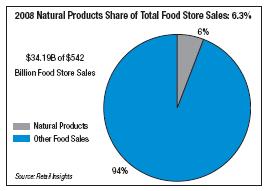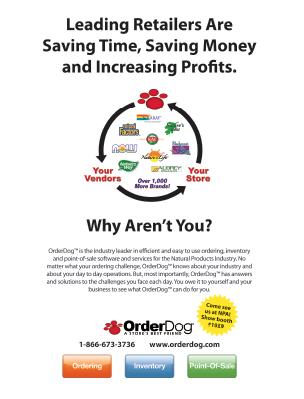At Retail Insights, we’ve recently completed our 2008 retail food industry overview, and natural products are $34.19 billion, or about 6%, of the $542 billion total food store business. If you just continue the trend lines as they’ve been going, with natural products growing 8% per year versus conventional foods growing 1% per year, by the year 2040, natural products will be $400 billion, or 54%, of the then-$745 billion retail grocery business. In other words, we will increase to 10 times our present size, adding $365 billion on top of our current $34 billion.

At Retail Insights, we’ve recently completed our 2008 retail food industry overview, and natural products are $34.19 billion, or about 6%, of the $542 billion total food store business. If you just continue the trend lines as they’ve been going, with natural products growing 8% per year versus conventional foods growing 1% per year, by the year 2040, natural products will be $400 billion, or 54%, of the then-$745 billion retail grocery business. In other words, we will increase to 10 times our present size, adding $365 billion on top of our current $34 billion.
Who Will Get All This Business?
Imagine for a moment that you are on the new-product development team at Unilever, Kraft, Procter & Gamble or Pepsi. Do you believe for a moment that these R & D types are sitting around thinking about the next high-fructose corn syrup, hydrogenated soy oil, two-year shelf life preserved, sweet or salty SKU, packed 120 cases to a pallet, that they can mass-market to U.S. households? Of course not!
 With major metropolitan cities outlawing trans-fats and Congress planning to tax carbonated soft drinks to fund health care reform, incumbent managements at the major food companies are scrambling to find Plan B. Bad ingredients are out, good ingredients are in.
With major metropolitan cities outlawing trans-fats and Congress planning to tax carbonated soft drinks to fund health care reform, incumbent managements at the major food companies are scrambling to find Plan B. Bad ingredients are out, good ingredients are in.
No War, No Bra, No Preservatives
The natural products movement was part of the counterculture revolution of the 1960s, which included Vietnam War protests, the free love movement and a desire to get back to the Earth, to a simpler less-processed way of life. For example, many early natural foods stores had their own stone mills, grinding wheat berries into fresh whole wheat flour. The youthful ideology of change drove devotees to shop almost entirely in newly created natural foods stores. These were the first “core” natural shoppers.
Today, while more than nine in 10 U.S. adults say they believe that good food is related to good health, only about one in 10 actually shops this way. The eight in 10 that do not devote a majority of their food dollars to natural and premium products buy a few things here and there. A bag of organic salad greens to get junior off on the right foot, but conventional broccoli for dad—because it hasn’t killed him yet. A nitrate-free meat for Johnny’s school lunch, but back to McDonalds for dinner—there’s not enough time to cook tonight.
 Commitment to natural products in today’s culture is a mile wide and an inch deep. Many more households than ever before have a few natural products in the pantry, but those products typically get there via the conventional supermarket. If you are a veteran independent natural products retailer, ask yourself how much non-dairy beverage or jarred tomato sauce you sell today compared to 15 years ago. The Unilevers, Krafts and Kelloggs of the world have caught on and created—or acquired—their own natural/organic offerings in these categories, and are eyeing more categories all the time. The result is that non-core natural shoppers—who are creating most of our industry’s growth—have no need to go out of their way to make a separate shopping trip to your store to get these items. There is not the burning ideological desire that motivated core natural shoppers, and they just aren’t making core natural shoppers anymore.
Commitment to natural products in today’s culture is a mile wide and an inch deep. Many more households than ever before have a few natural products in the pantry, but those products typically get there via the conventional supermarket. If you are a veteran independent natural products retailer, ask yourself how much non-dairy beverage or jarred tomato sauce you sell today compared to 15 years ago. The Unilevers, Krafts and Kelloggs of the world have caught on and created—or acquired—their own natural/organic offerings in these categories, and are eyeing more categories all the time. The result is that non-core natural shoppers—who are creating most of our industry’s growth—have no need to go out of their way to make a separate shopping trip to your store to get these items. There is not the burning ideological desire that motivated core natural shoppers, and they just aren’t making core natural shoppers anymore.
Is Gluten-Free the Next Low-Carb?
As I speak to naturals retailers around the country, I’m frankly concerned how large a share of sales gluten-free has become. I am reminded of the low-carb craze of 2004, where overly exuberant independents opened entire low-carb stores, only to have mass-marketers grab the lion’s share of the business as the fad fizzled out less than a year later.
Although gluten-free is probably a trend, not a fad, with perhaps tens of millions more who will be diagnosed with celiac disease in the coming years, independent natural products retailers now face a hungry, more savvy mass market that will have no trouble creating, say, 24-foot sets of gluten-free foods, once again stealing natural retailers’ thunder.
While for the moment, gluten-free products have semi-exclusive availability through natural distributors, conventional distributors such as SuperValu and C & S, and large retailers such as Kroger and Safeway will jump on this major packaged foods trend. Wal-Mart already advertises over 800 gluten-free foods in its house brands, and the major packaged food companies are certainly developing gluten-free options. And, if conventional supermarkets were willing to invest in private label organics, they will gladly—and fairly easily—adopt gluten-free as well.
Who Gets the Business?
Most U.S. households now buy at least some natural products, and all major food producers, distributors, conventional supermarkets and mass merchants vigorously compete for natural market share, so everyone is going to get a piece of the pie. At a recent seminar, an attendee asked me, “Since conventional supermarkets aren’t truly knowledgeable about natural products, will they ultimately fail and have to stop selling them?” While I can appreciate the sentiment of the questioner, and my heart—and Retail Insights’ mission as a company—is dedicated to helping independent natural products retailers succeed, hoping supermarkets give up is not a useful frame of mind for independent retailers.
I am reminded of a saying from Africa: When the elephants fight, it is the ants that get trampled. Independent retailers are under pressure, but those who take the time to figure out why their business attracts customers—and do more of that—can avoid being crushed underfoot by mainstream food marketers.
Independent retailers who recognize that they may need to change the way they do some things, be a bit more proactive in some areas and invest in the business to become more relevant to new, non-core natural shoppers, will enjoy the fruits of these labors as our industry continues its climb toward dominating the conventional food business. WF
Jay Jacobowitz is president and founder of Retail Insights®, a professional consulting service for natural products retailers established in 1998, and creator of Natural Insights for Well Being®, a holistic consumer marketing service designed especially for independent natural products retailers. With 31 years of wholesale and retail industry experience, Jay has assisted in developing over 800 successful natural products retail stores in the U.S. and abroad. Jay is a popular author, educator, and speaker, and is the merchandising editor of WholeFoods Magazine, for which he writes Merchandising Insights and Tip of the Month. He can be reached at (800)328-0855 or via e-mail at jay@retailinsights.com.
Published in WholeFoods Magazine, July 2009










